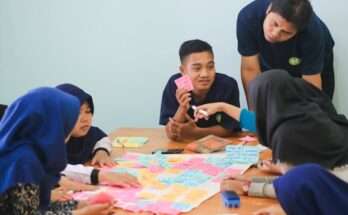Design Thinking A Human Centered Approach to Innovation, Human-centered design thinking, also known as human-centered innovation or simply design thinking, has become an increasingly important approach to business and design in the past two decades. Design thinkers believe that problem solving isn’t purely about logic and data but also about empathy and creativity—in other words, approaching problems in a human-centered way. As you might imagine, this requires different methods than traditional engineering or scientific thinking might use, but as more businesses embrace the design thinking process, it’s becoming clear that it can lead to some innovative solutions.
- What is human Centred Design thinking?
- The 3-Step Problem Solving Process
- what is ideo design thinking?
- What is Enterprise Design thinking?
- what are Design thinking and innovation?
- How Brainstorming Works in Design thinking
What is human Centred Design thinking?
Human Centred Design (HCD) is a design methodology that starts with people and the needs they have. HCD applies design thinking principles in order to create solutions that are practical, usable, and desirable. In other words, HCD puts people at the center of the process. This approach has been applied across different sectors by global organizations such as Nike, IDEO, and Google. Mental Health Awareness Week on mental health and creativity

In celebration of Mental Health Awareness Week, I wanted to share some information on how design can help improve mental well-being. The following are some key elements of human-centered design (HCD) that may help in this endeavor:
The importance of inclusion People who are designing products or services should take into account all user groups, including people with disabilities or elderly populations. It’s important not only for designers to be aware of these challenges but also for everyone else involved in the product development process—from stakeholders and clients to production partners. How does this matter?
The 3-Step Problem Solving Process
- Define the problem and establish objectives
- Generate and evaluate ideas
- Implement the best idea that meets your objectives
The process of design thinking is also known as human-centered design thinking. It’s a process in which designers use their imaginations to solve problems, rather than relying on what they know already or what has worked in the past. Design thinkers identify a problem, find ways of getting feedback from potential users, and do things with people, not just for them. They create interactive experiences where they invite people into their designs, so they can gain a better understanding of how they react to them before spending any time or resources building it out. Designers must be willing to make mistakes because you’ll never get anywhere without trying new things. So, if you’re looking for an innovative way to approach your next project and are willing to take risks while developing a solution, human-centered design may be right up your alley.
Design thinking isn’t just for design. Actually, almost every industry can take advantage of its unique process. Entrepreneurs and startup founders who are looking for a new approach to solving problems with their products or services should pay attention, too. Rather than simply jumping into building a product or service on your own, using human-centered design could provide you with a better understanding of how users interact with your product or service before actually rolling it out. The goal is not just solving your original problem but also creating solutions that could solve problems others have encountered as well – making them much more valuable than if you came up with them alone in isolation. Finally, teams within larger organizations will also find value in taking on human-centered design thinking.
what is ideo design thinking?
Ideo is a global design and innovation company headquartered in California. Originally founded in 1989 as the David H. Koch Center for Applied Research at MIT, we have developed a human-centered design process that has helped shape and transform industries around the world.
This process, called Design Thinking, creates products and services that meet people’s needs while also solving complex problems. We apply Design Thinking in everything from healthcare to IT and from education to enterprise software. Our goal is not just innovation for innovation’s sake but rather innovation with an impact on society as a whole.
Throughout our history, we have faced challenges that no one else had ever solved and helped create breakthrough solutions with innovative technology. Our work is based on insights gathered from understanding people’s everyday lives, which allows us to go beyond creating beautiful new designs and developing technology for technology’s sake. We strive for solutions that have a true impact—improving a person’s health or changing an entire industry. With a process rooted in human experience, Design Thinking helps us see what others miss so we can deliver what people need in ways they could never imagine. And it makes doing business better for everyone involved.
Inventive, no matter what your business or challenge, video can help you create innovative products and services that improve lives. We have a proven methodology and collaborative approach that will inspire everyone involved in a project to do their best work and achieve great results. Design is not just about creating beautiful objects but also creating better experiences—for people in their homes, in businesses, and across entire industries. Whether you’re designing software for education or medical devices for healthcare, we can help you develop technology that improves lives by addressing needs at a human level. That’s why we don’t just make things—we invent them.
What is Enterprise Design thinking?
Enterprise design thinking is a human-centered approach to innovation that can be used by any organization. It starts with an empathy lens and moves towards co-creation and understanding of contexts. Design thinking is a process or methodology rather than a tool, but it relies on many different tools to achieve its goals. Enterprise design thinking is about designing for the end user and not just for business needs. This means considering what people need, want, desire, and how they will use the product or service you are designing. Another important aspect of design thinking is testing designs with users in order to identify problems early in the process before investing time and money into developing something that may not work.
One of the important aspects of design thinking is testing designs with users. There are a couple of different ways to do it, but one involves sketching up your idea as quickly as possible and then showing it to potential users for feedback. This is called low fidelity prototyping and it is useful for understanding how users think about your product or service and if they can easily understand what you’re trying to achieve. Another method of design thinking testing involves high fidelity prototyping, where you show a more polished version of your idea for testing instead. This requires more time and effort on your part but helps build confidence that what you are creating will be useful or desirable once it goes into production.
what are Design thinking and innovation?
Design thinking is a human-centered approach to innovation. It is a collaborative and inclusive process that starts with empathy and understanding the needs of others. Design thinking helps you see problems from all sides, including the people affected by them. The process encourages divergent and convergent thinking and can be used for solving complex challenges of an individual, organization, or community. When starting a design project, first gather information about what you want to do and then start brainstorming solutions. From there on out think about how your solution will affect people’s lives – would they like it? Is there any other way this problem could be solved? When designing for children, for example, make sure the toys are age appropriate so they are safe and functional.
Design thinking was invented by David Kelley, founder of IDEO, a design and innovation consultancy in Palo Alto, California. Empathy is a crucial part of design thinking as you start by recognizing people’s needs or wants. This can be challenging at first if it’s something you aren’t used to. Start small and simple and work your way up – take some time out of your busy schedule to really listen to what others are saying about their problems or struggles.
You can use design thinking in many different industries. Design thinking has been applied to business, medicine, education, and nonprofits. There are even design thinking methods for entrepreneurs looking to start up a small business or non-profit organization. As a rule of thumb, if you want some outside perspective on your ideas, do not think about it too long. The longer you sit on an idea without feedback from others, especially experts in that field, the less likely your idea is going to be successful or innovative. Although it is always good to come up with multiple solutions so you can choose which one will work best. The goal of design thinking is not only innovation but also creation – designing products and services that people need and want today!
How Brainstorming Works in Design thinking
Brainstorming is a design thinking technique that can be used to generate ideas and solve problems. Brainstorms are often done in groups, with each group member contributing as many thoughts as possible. Group members should think out loud but only share their ideas with the group if they feel comfortable doing so. The goal of brainstorming is not for people to agree on one idea and proceed with it, but for people to agree on one idea and then come up with a different solution. Design thinkers will put together two lists: yes and no or maybe. They will look at both lists to see if there are any common points where both lists have agreement or disagreement. From this list, some solutions may arise.
Write a professional short story based on one of these fictional characters and their life experiences. For example, if your character is a doctor, write about them being assigned to a hospital in some distant country where they have very little in terms of medical resources at their disposal. Or, if they are an architect, talk about how they designed a skyscraper that was recently destroyed by an earthquake. Don’t try to include every detail of their life but choose important events that would fit into a five hundred-word format.
Brainstorming is a creative technique that aims to generate as many solutions or ideas as possible. This way of thinking works on three levels, firstly it allows people from different backgrounds and experiences to provide a new perspective that may have been missed by others. Brainstorming also means divergent thought, where people are not holding back on their ideas and fully expressing themselves without fear of being judged or criticized. Finally, brainstorming generates several solutions that aim at overcoming obstacles in any given problem situation. People who work together will bring forward common problems they might face while others find ways of dealing with them.




